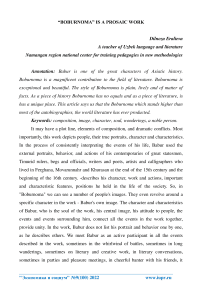“Boburnoma” is a prosaic work
Автор: Eralieva D.
Журнал: Экономика и социум @ekonomika-socium
Рубрика: Основной раздел
Статья в выпуске: 9 (100), 2022 года.
Бесплатный доступ
Babur is one of the great characters of Asiatic history. Boburnoma is a magnificent contribution to the field of literature. Boburnoma is exceptional and beautiful. The style of Boburnoma is plain, lively and of matter of facts. As a piece of history Boburnoma has no equals and as a piece of literature, is has a unique place. This article says us that the Boburnoma which stands higher than most of the autobiographies, the world literature has ever producted.
Composition, image, character, soul, wonderings, noble person
Короткий адрес: https://sciup.org/140299299
IDR: 140299299
Текст научной статьи “Boburnoma” is a prosaic work
These conflicts arose from the conflicts between the poet and scholar Babur and the king Babur. Babur, a representative of the feudal class, oppresses the country as a political measure to consolidate his power. He attacks the entire tribes, especially the property of the tribes who disobeyed and fought for their freedom and freedom, exterminated many of them, and built towers like his grandfather Temur. Sometimes he imposes heavy taxes on the head of the people, which makes him desolate. He will divide the provinces and cities he has won to his sons and noble officials. As I ordered, the pilgrims stood far from the julya, they said a few blessings, there was no special movement at the grave, when I went, they broke the julya and built a dome over the grave. This action was banned under the threat of mujavirs. Such views are reflected in his attitude towards astrologers. All these, of course, are not accidental, but advanced ideas closely connected with one or another concept of religion, with anti-clerical motives expressed in the poet's lyrics in relation to ignorant priests. They are an important aspect of Babur's character. Thus, Babur's own portrait and character, characteristics were shown with his multifaceted signs, positive and negative aspects against the background of all the historical events described in his work.
LIST OF USED REFERENCES :
-
1. Boburnoma. Publishing House of the Academy of Sciences of Uzbekistan, 1960. -B. 62-63.
-
2. Jena Krusnachandra. Baburnama and Babur. Delhi, 1978.
-
3. Laf Muni. Babar. Life and Times, New Delhi, 1977.
-
4. Lamb H.A. Babur the Tiger, first of the Great Moguls, etc., London, 1962.
-
5. Nath R. India as seen by Babur, New Delhi, 1996.
-
6. Gaibullah al-Salam, Nematullah Otajon, Jahangashta "Boburnoma", Tashkent, 1996
-
7. Grenard Fernand, Baber, fondateur de liempire des Indes, 1483-1530, Paris, 1930, Grenard Fernand, Babur. Prepared by Orhan Yuksel, Istanbul, 1971.
-
8. Kholbekov M. Babur in Farangistan. Literary and Art Newspaper of Uzbekistan, October 19, 1990.
-
9. Muni Lal. Last trip. Uzbekistan literature and art newspaper, 1990.
-
10. T. Saydaliev. Translation and poetic arts. World literature, 2008.
"Экономика и социум" №9(100) 2022
Список литературы “Boburnoma” is a prosaic work
- Boburnoma. Publishing House of the Academy of Sciences of Uzbekistan, 1960. -B. 62-63.
- Jena Krusnachandra. Baburnama and Babur. Delhi, 1978.
- Laf Muni. Babar. Life and Times, New Delhi, 1977.
- Lamb H.A. Babur the Tiger, first of the Great Moguls, etc., London, 1962.
- Nath R. India as seen by Babur, New Delhi, 1996.
- Gaibullah al-Salam, Nematullah Otajon, Jahangashta "Boburnoma", Tashkent, 1996.
- Grenard Fernand, Baber, fondateur de liempire des Indes, 1483-1530, Paris, 1930, Grenard Fernand, Babur. Prepared by Orhan Yuksel, Istanbul, 1971.
- Kholbekov M. Babur in Farangistan. Literary and Art Newspaper of Uzbekistan, October 19, 1990.
- Muni Lal. Last trip. Uzbekistan literature and art newspaper, 1990.
- T. Saydaliev. Translation and poetic arts. World literature, 2008.


